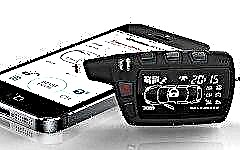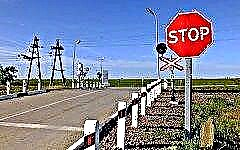

The content of the article:
- Railway crossing and its dangers
- Liability and penalties
- Prohibitory signal
- Stopping the car
- Overtaking
- Controversial points
After a major accident that occurred in October 2017 at a railway crossing in the city of Pokrov, Vladimir Region, the Ministry of Transport and the Ministry of Internal Affairs thought about the possibility of increasing the fine for this offense.
Let us remind you that the bus carrying 57 people stalled right on the railway tracks. The driver asked the passengers to help roll the bus aside - this saved the lives of the volunteers. The speeding train rammed the bus, which led to the death of two dozen people who slept in the cabin.
Earlier, a proposal was put forward to raise the fine to 30 thousand rubles, but the government considered an increase of 30 times unnecessary. Now the bill includes a figure of 5,000 rubles for motorists who break the rules when crossing tracks.
The Ministry of Transport reported an increased accident rate on the railway, although even in traffic rules, crossing them is called an action with an extremely high risk for all vehicles. Therefore, the punishment for non-compliance with the rules must be toughened.
Railway crossing and its dangers

A level crossing is one of the most dangerous sections of the road, because any incident within it almost always leads to serious consequences that end in death. Therefore, punishments for violations of the rules during its crossing must be and, as practice shows, must become more serious.
The crossing area, within which dangerous maneuvers are not permissible, begins at a distance of 100 meters to the road line, as indicated by the corresponding road sign.
Liability and penalties

The danger of illegal maneuvers at level crossings threatens not only the reckless driver, but also his driver, car and train passengers. All of them, one way or another, can suffer in the event of an accident on the railway. Thus, the applied sanctions should not only punish the violation, but absolutely exclude its likelihood and even the very idea of making a dangerous maneuver.
Depending on the degree of guilt of motorists for violations at level crossings, the Administrative Code specifies in detail the methods of punishment for each illegal action. It is expressed either in a monetary fine or in deprivation of rights for a certain period. In particularly serious cases, both measures can be applied at the same time.
Prohibitory signal

All railway crossings are necessarily equipped with either a barrier with a traffic light, or just one traffic light. The penalty will be applied to those drivers who:
- did not stop the car in front of the stop line located 5 meters before the tracks;
- continued to move with the lowering barrier;
- in the absence of a stop line or a barrier, they did not stop 10 meters before the start of the track
Traffic police officers, on the basis of many years of practice, report that too many car owners do not know either the rules of behavior at level crossings, or the amount of the fine imposed for crossing paths to a forbidding light. And although ignorance of the law does not absolve of responsibility, part of the blame for poor information among motorists should be placed on police officers.
The punishment for this violation is established by Part 1 of Article 12.10 in the amount of a fine of 1,000 rubles. The same paragraph of the article assumes a more severe punishment - deprivation of rights for a period of 3 to 6 months. If within a year from the moment of the incident the driver breaks the rules again, he will see his rights only after a year.
Although this rule is extremely simple and straightforward, it is this rule that leads in the number of violations. The ideal solution to the problem is automatic barriers, which make it impossible for overly hasty drivers to slip through the redirection signal. Unfortunately, there are still too many crossings with only traffic lights, and a small fine is not an obstacle for reckless drivers.
Stopping the car

Every driver and just a reasonable person understands that it is impossible to stop on the tracks under any circumstances. Traffic rules are implacable in this case and threaten with a penalty in the amount of 500 rubles.
This penalty is imposed for the following violations:
- before the crossing there is either a stop line or the stop sign itself is installed, in both cases the driver must stop. If he did not, then part 2 of Art. 12.10;
- even if the stop is forced (breakdown, lack of gasoline), this is not a mitigating circumstance. Depending on what article the law enforcement agencies qualify the offense, the fine will be 500 or 1000 rubles.
This also applies to those impudent motorists who start driving at the first warning sounds, trying to have time to pass the crossing. However, they realize that they will not have time to complete the action. What to do? Since the rule has already been violated, it is impossible to stop on the tracks - you should either turn back if the car has just arrived at the railway track, or have already crossed the crossing to the end.
Actions in a situation where a sudden breakdown occurred directly at the crossing and the driver cannot quickly solve the problem are described in detail in clause 15.5 of the Road Traffic Regulations:
- First of all, the owner of the car is obliged to drop off his passengers, and he himself must try to free the crossing.
- If there were passengers in the car, they must move away from the crossing in both directions at a distance of a thousand meters and give warning signs to the approaching train. If the passenger was alone, he should walk in a direction of less visibility to prevent a collision. To do this, one should take a bright matter, a lantern or other object that is well distinguishable even in the dark, and make circular movements with it.
- If it is not possible to roll back the car, the driver must signal the alarm with a series of 1 long and 3 short beeps.
By following these basic safety rules, a terrible catastrophe can be prevented. The huge weight of the train significantly lengthens its braking distance, so it is so important to warn the driver in time. To do this, you can ask to become "messengers" of other motorists or even passers-by if the culprit was alone in the car.
Overtaking

At the level crossing, no maneuvers are allowed, especially bypassing a static object or overtaking other vehicles.
A detour is considered an offense if it is accompanied by an exit into the oncoming lane. In this case, the driver is held liable under Part 3 of Article 12.15, which stipulates a fine of 1000-1500 rubles.
If, when bypassing any static obstacle located directly at the crossing, the oncoming lane did not leave, then the traffic rules do not provide for liability for such an action.
Overtaking, which also involves driving into the oncoming lane, will cost the violator, according to Part 3 of Art. 12.15 Administrative Code, more expensive - 5000 rubles or deprivation of rights for 4-6 months.
Controversial points

Often, road situations become very controversial, pushing the heads of motorists and traffic police officers. In the context of railway crossings, such a nuance can be the raising of the barrier before the prohibiting traffic light turns off. In this case, the cars start moving, but on the other side of the crossing, inspectors are already waiting for them in order to fine them for non-observance of the prohibition signal.In response, legally savvy drivers can refer to the Instruction for the operation of railway crossings, according to which the red signal should not be turned on if the barrier is already raised.
When a police officer draws up a protocol on the fact of driving on a prohibitory signal, the driver should point to clause 6.14 of the SDA. He says that if the car was in the immediate vicinity of the barrier, which was still raised at the moment when the traffic light came on, it can continue driving. Since emergency braking or reversing is still prohibited on a level crossing.
If the driver broke the rules at a crossing equipped with automatic barriers, he can draw the inspector's attention to the fact that once the barrier was raised, then the traffic signal was by definition permissive. Most often, this is enough to end the dispute.
Judicial practice speaks of a significant percentage of cases in the total mass of administrative proceedings on traffic rules related to violations of traffic rules at a railway crossing. At the same time, the majority of car owners showed ignorance of both the rules for crossing a dangerous section and the measures of responsibility for their violation.











